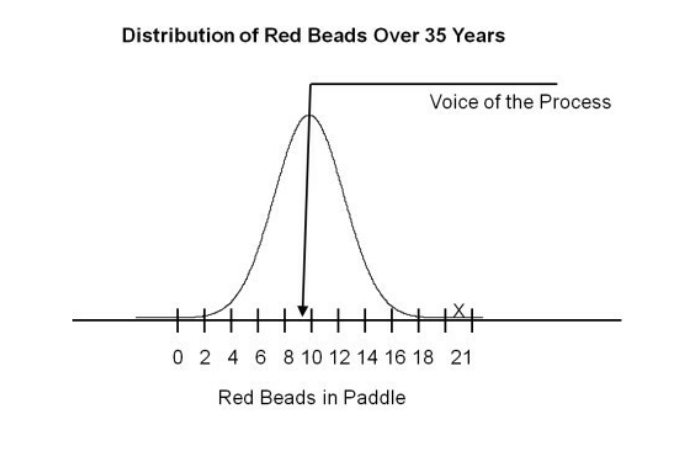Red Beads, the Root of all Evil
Misunderstanding Variation is the Root of all Evil - Botchagalupe
https://demingcollaboration.com/product/red-bead-game/
According to W. Edwards Deming, variation is an inherent part of life and needs to be managed to improve a system. According to Deming, the prevailing system of management destroys people's intrinsic motivation, self-respect, dignity, and curiosity to learn. As he describes in one of his famous quotes, the system is responsible for 94% of quality issues, not the individual. There is no better example of this philosophy than his Red Bead Game. Deming used the concept of his Red Bead Game back in the 1950s when he arrived in Japan. However, the game is probably most known from his Four Days with Deming seminar in the 1980s.
Deceptively simple, the red bead game delivers a powerful message that many people cannot comprehend. In the game, six workers are instructed to collect only white beads (zero defects) with a paddle from a container of mixed-colored beads. The willing workers are trained to use the paddle, but the system is flawed by design. The container they are using to pull the beads from is made up of 4000 wooden beads (3,200 white and 800 red). Each worker is given a paddle with 50 depressions to scoop out the beads. Statistically, each paddle with 50 beads should average around ten red beads per scoop (i.,e, twenty percent). Deming adds a mechanical twist to add human randomness to the game by instructing the worker to use a specific angle when gathering the beads.
The game illustrates how variation is part of a system in what he calls common cause variation. In William Sherkenbach's "The Deming Route to Quality and Productivity," he suggests that over 35 years of administering the Red Bead Game, the range of red beads is 2 to 12 with only once a count of 21.
William Sherkenbach's "The Deming Route to Quality and Productivity”
In my simulation of around ten thousand samples, the average red bead count was about 10.15. Because of the flawed distribution, a willing worker's red bead average count will never be zero and, more often, closer to ten. Blaming or rewarding workers for their red bead count is considered tampering. Tampering occurs when common cause variation is mistaken for special cause variation. A special cause is an unexpected variation in a process that can be attributed to a specific reason. In the case of the Red Bead Game, the bead distribution is the common cause of process variation. Deming would argue that the distribution of white to red beads is a supplier issue, and all red Bead counts are therefore inherent to the process. It is the management's responsibility to fix it, not the willing workers.
I've created a simulation of the Red Bead Game to illustrate how ranking and performance reviews can be a form of tampering. After analyzing some of the data of their workers, Company X realizes they are a far cry from zero defects (i.e., zero red beads). Still determined to control the process (tampering), they decided to use a scorecard process. In its simple form, they choose the following:
Green - Less than 10 red beads
Yellow - From 10 to 12 red beads
Red - Greater than 12 red beads
Figure 1
Figure 1 shows six workers' performance over six days. Bob scores exceptionally well; he is first in the rankings after six days. John and Julie are also doing a good job, except Julie had a bad streak on days three to five but recovered exceptionally well on day 6. Company X is on the fence regarding Sue, but Tom and Maya must be fired.
Figure 2
In Figure 2, we see an example of Company X bringing in a new manager, where she decides to take a different approach. First, she replaces Tom and Maya with workers from her old company, Alan and Vicki. The other thing she does is focus on white bead output instead of red beads. As expected, Vicki delivered as promised with the highest white bead average over six days. All willing workers were also asked to set their Objectives and Key Results (OKRs). Each worker put an OKR of greater than 40 white beads. Sue and Bob both met their OKRs, but Alan fell short. The new manager was quite pleased with Sue and Bob. She determined that Alan needed more time to get used to the new company. Because John is close to meeting his OKRs, the new manager sends him for further training.
An outside observation of Company X's scorecard suggests that this circus will continue forever. Deming calls the workers "willing workers" because he believes most workers want to do a good job. However, the nature of the system often limits their success. A worker's performance is the result of a combination of many forces, the people who worked the job, the material they worked on, their customers, management, supervision, environmental conditions, and, often, just plain old confusion.
There was no evidence that any one worker was better than another.
The experiment was a display of bad management.
The Willing Workers on the Red Beads were victims of the process.
It would have been good had the management worked with the supplier of beads to try to reduce the proportion of red beads in the incoming material.
Summary of Lessons from the Red Beads by Dr. Deming form New Economics
Dr. Deming used the Red Bead Experiment in his eight-day seminar for Japanese engineers in 1950 and 1951. Dr. Kaoru Ishikawa observed that the proportion of red beads in the sample differed from that of the incoming material. He extrapolated this to a real-world example of how the Japanese tested iron ore. Traditionally, samples were taken from the top of the pile after all the iron ore had been loaded. To obtain samples throughout the pile, they altered the sampling process to halt the conveyer belt at random intervals. This new method revealed ten percent less iron from certain mines. As a result, samples of iron ore were classified more accurately.
Dr. Deming spent a lifetime trying to change the prevailing system of management by looking beyond simple numerical goals and basic assumptions. The Red Bead Game is an excellent example of how misunderstanding variation can be the root of all evil.



